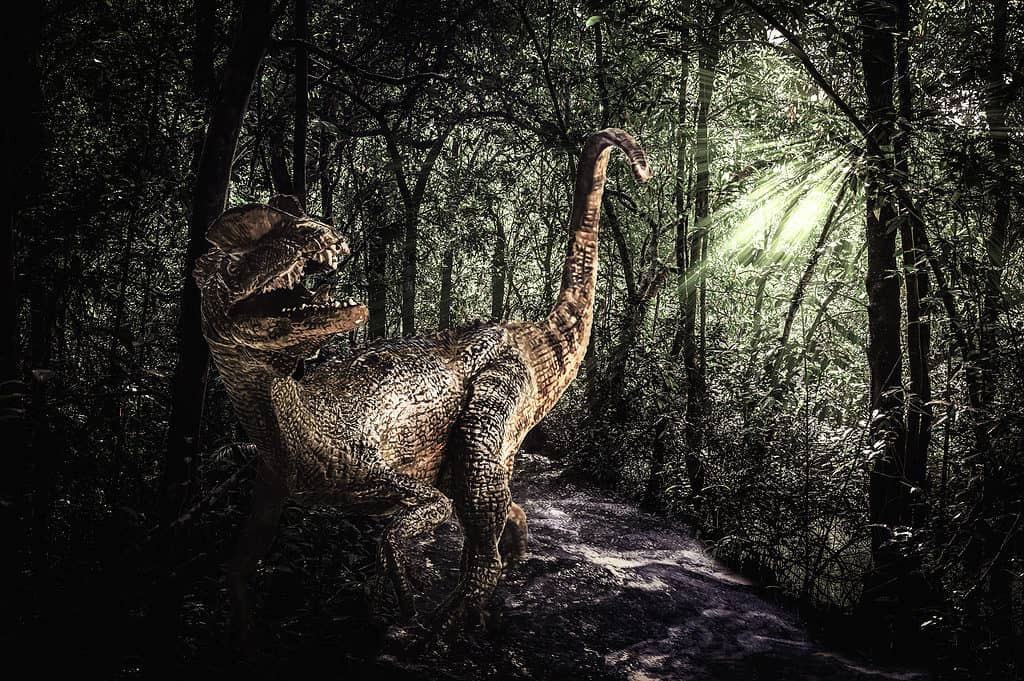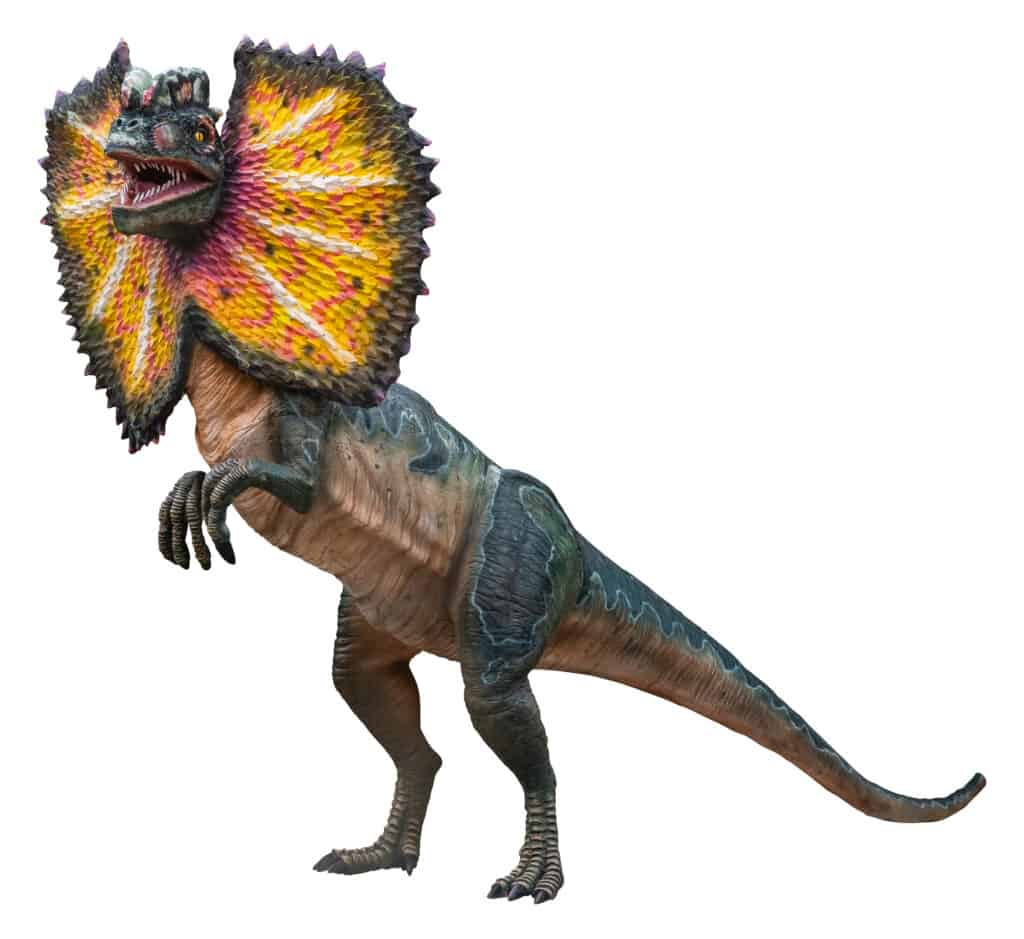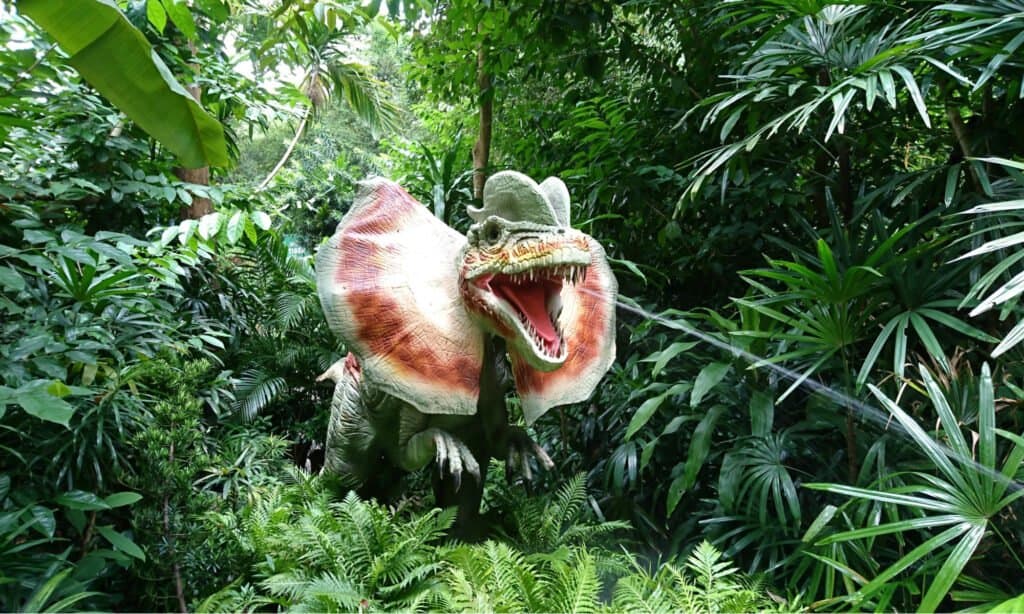Movie buffs may remember the Dilophosaurus as the scary neck-frilled, poison-spitting dinosaur of the original Jurassic Park movie. The one you don’t want to get locked in a jeep with when you’re trying to escape with stolen dinosaur DNA.
However, the real-life Dilophosaurus was quite a bit different, though just as scary to share a vehicle with. The largest specimen ever discovered was 23 feet long and would have weighed about 880 pounds! Read on to learn more about this unique Early Jurassic dinosaur with movie star power!
When and Where Did Dilophosaurus Live?

Dilophosaurus likely lived in forests along rivers, where they could eat both terrestrial animals and fish.
©iStock.com/Kitti Kahotong
Dilophosaurus lived about 186 million years ago in the Early Jurassic Period. Paleontologists have discovered its fossils and footprints in Arizona. The area had thriving coniferous forest ecosystems along rivers with sand dunes beyond. During dry seasons, the dunes encroached on the well-watered land, beginning the process of encasing them in sand that would eventually become sandstone. Dilophosaurus may also have lived in swamp-like or tropical rainforest conditions as the climate changed over time.
What Did Dilophosaurus Look Like?

Dilophosaurus had a large, crested head, powerful hind legs, and shorter forelegs.
©YuRi Photolife/Shutterstock.com
Dilophosaurus was a medium-sized theropod dinosaur, meaning it walked upright on two legs like T-Rex. It was nowhere near as big, though. The largest specimen ever discovered was 23 feet long and would have weighed about 880 pounds. The species had a large head for the size of its body with two crests on its skull. The largest fossilized skull of Dilophosaurus was a little over 23 inches long. Its long, curved, serrated teeth were angled out to the sides, somewhat like a shark. The arm bones were long and thin with four-fingered hands and long claws. It had large, powerful thigh bones and big feet with large claws.
What Did Dilophosaurus Eat?
This species ran on its hind legs and was the largest carnivore in North America during its time on Earth. It could have easily fed on smaller animals. Some structural elements of its jaws and teeth were similar to crocodiles, suggesting it may have also fed on fish. Although some scientists say that its jaws were too small for hunting larger animals, others have said that it was more than capable of doing so. Its forelimbs were shorter than its neck, so it is likely that it grabbed prey with its teeth instead of its claws.
What Did Jurassic Park Get Wrong About Dilophosaurus?

Dilophosaurus in real life did not have a neck frill.
©YuRi Photolife/Shutterstock.com
The 1993 movie Jurassic Park, adapted from the 1990 novel of the same name, made Dilophosaurus into one of the scariest dinosaur villains of a disastrous genetic engineering experiment. The author and the film’s creators acknowledged that of all the dinosaurs represented in the movie, the depiction of Dilophosaurus was the most fictionalized. These are some of the Hollywood elements that wouldn’t pass science class:
- Spitting poison to kill prey was an invention. It actually had relatively weak jaws.
- Its retractable, vibrating neck frill was stolen from the modern frill-necked lizard, not anything found in the fossil record for this species.
- It was scaled down from 10 feet tall to only 4 feet tall to avoid creating confusion with the velociraptors. (Incidentally, the velociraptors were scaled up in size. In real life they were the size of turkeys, had feathers, and didn’t even live in the Jurassic period!)
- Dinosaurs may have had different color patterns but no one knows exactly what they were.
What’s Good About Getting It Wrong?

Even though fictional, the Dilophosaurus in movies helped inspire future generations of paleontologists!
©Cheng Wei/Shutterstock.com
For educational purposes, it would be best to depict all the dinosaurs in movies in historically accurate ways. In that sense, it’s disappointing Jurassic Park took such liberties with the Dilophosaurus and the velociraptor. In fact, it’s hard to understand why the author didn’t just focus the story more on the Dilophosaurus, which lived in the Jurassic Period and was the size he wanted, instead of scaling up the velociraptor for that purpose. However, those changes do make the movie scarier, and they provide teaching moments about the real dinosaurs. The books and movies of this series have no doubt helped inspire many budding young paleontologists.
The photo featured at the top of this post is © Dotted Yeti/Shutterstock.com
Thank you for reading! Have some feedback for us? Contact the AZ Animals editorial team.






